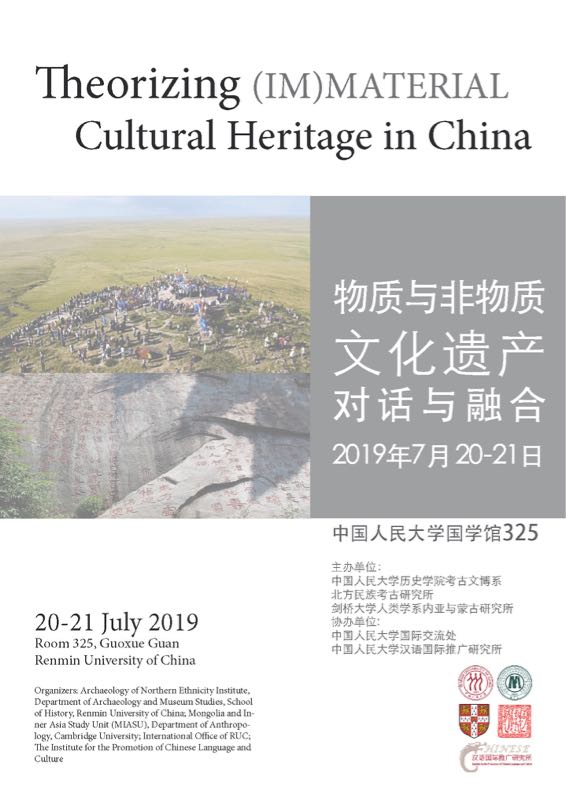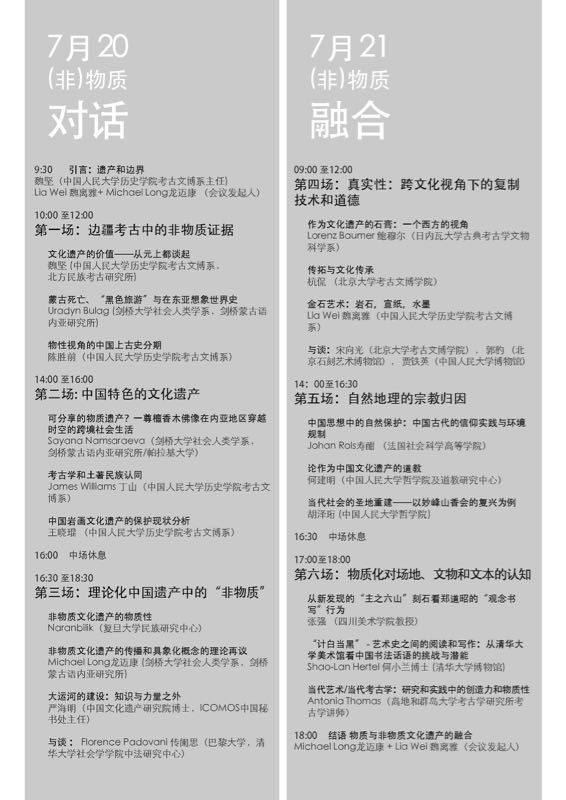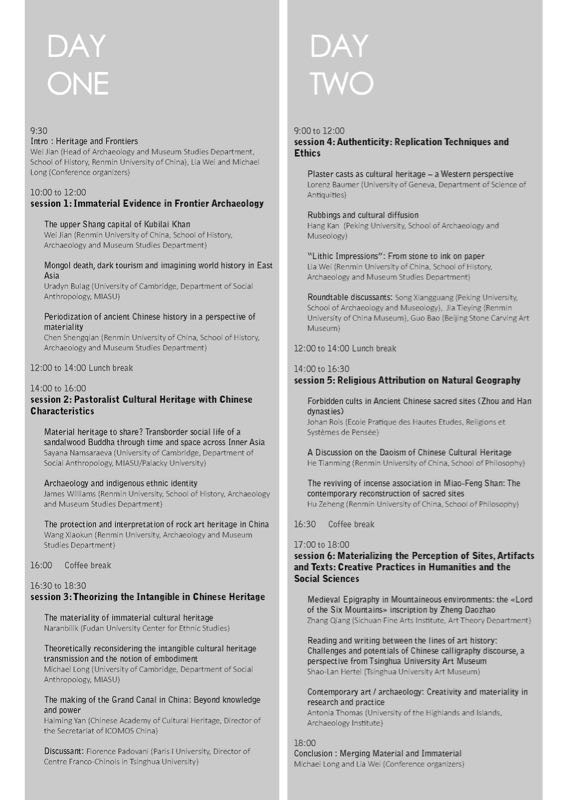通知公告
- 中国人民大学、国家文物局联合培养博士后2025年度招收公告
- 中国人民大学历史学院2024-2025学年春季学期博士后招收公告
- 清史研究所招聘启事
- 历史学院招聘启事
- 中国人民大学历史学院(含清史研究所)2025年度人才引进招聘通知
- 招聘 | 中国人民大学历史学院2024-2025 学年秋季学期博士后招聘公告
- 中国人民大学全国中小学德育教学骨干教师研修班招生简章 • 历史学院-招生简章
- 中国人民大学全国中学历史教学创新研修班 • 历史学院-招生简章
- 历史学院招聘启事
- 全国中学历史教师研修班招生简章
- 讣告:雷晟生同志逝世
- 顾学顺老师讣告
- 关于防止校外机构假冒我院名义举办在职课程培训班等培训项目的声明
- 第六届“茶道哲学优秀学位论文奖”评选活动通知
- [职员办] 历史学院招聘启事
- “整体史视野下的法律史研究”系列讲座之二十二 暨“明德法律文化论坛”第一〇五期
- 会议通知:从历史的视角理解COVID-19——中英学者对话
- “整体史视野下的法律史研究”系列讲座之二十 考古学视角下的早期中国 ——从文明起源到三代王朝
- 讣告:陈延昕教授逝世
- “史学前沿”第一讲:明清社会经济史视野下的“华北”概念及流变
- 预告:台湾大学项洁教授 演讲
- 【人大史学讲堂之八十一】印度现代化进程中的种姓问题
- 首届新史学青年著作奖 颁奖典礼
- 讲座预告:台北故宫博物院陈维新研究员演讲
- 讲座预告:台湾彰化师范大学陈文豪教授演讲
- 衣若兰:《多元交织与中国性别史研究》演讲预告
- 【“整体史视野下的法律史研究”系列讲座之十九】从秦律到隋律
- 《清史研究》变更为双月刊的启事
- 吴玉章学术沙龙2019年第16期 杨念群主讲
- 《马背上的朝廷》 分享
- 人大史学讲堂之八十:国际史和跨国史研究的新视域——以近代中美关系为例
- 讲座|战争足迹:越南空间史上的军事化
- 讲座 | 裘皮与帝国——从奢侈品消费看清史
- “清代《缙绅录》的文本与量化研究”工作坊议程
- 【人大史学讲堂之七十九】从异教到基督教转型中的情感
- “大历史·全球史家对话”系列活动之三 | 一个现代起源故事,及其对今日世界的启示
- 三山五园文化传承校园宣传日活动预告
- 关于遴选第九届北京高校研究生考古论坛代表的通知
- 中国人民大学历史学院清史研究所第十一届青年学者论坛邀请函
- 预告:波士顿大学梅欧金教授演讲
- 预告:阿克伦大学赵刚教授演讲
- 会议预告| 物质与非物质文化遗产对话与融合
- 我院朱浒副院长入选第六届中国地方志指导小组
- 首届“新史学青年著作奖”评选公告
- 环境主义与瑞典的林纸企业 ——以斯道拉恩索为例
- 2019年《中国历史官员量化数据库——清代》暑期工作坊录取名单及相关事项
- 讲座 | 廉价与权力:资本世简史(5月21日,周二)
- 讣告:黄文皆先生逝世
- 人大青年史学工作坊“讲历史”系列演讲(100期暨六周年特别活动)
- 《五四的另一面》新书分享会

会议预告| 物质与非物质文化遗产对话与融合

会议海报(poster)

会议日程

meeting agenda
会议内容 本次会议由中国人民大学历史学院考古文博系、北方民族考古研究所与剑桥大学蒙古与内亚研究所(MIASU)联合举办,由中国人民大学国际交流处和中国人民大学汉语国际推广研究所协办。会议为期两天,由讲座和讨论两部分构成。第一天的讲座从地域性出发,着重强调内亚草原和古代中国的“边界”,比较地域文化考古学与人类学的研究成果,在方法和理论层面探讨“非物质”(intangible)概念。 第二天根据当下博物馆研究、宗教研究和创意实践中正在进行的项目,围绕真实性、宗教场所和感知三个主题,探索中国文化遗产中“物质”和“非物质”之间的界限。 会议缘起 目前,中国在全面建立文化遗产保护体系(包括“物质”以及“非物质”文化)方面取得了长足进步,也在努力融入国际文化遗产保护话语及文化遗产保护制度之中。尽管中国还是通过国际公认的保护规范对中国的文化遗产进行保护,中国的独特历史和国情也使人们在文化遗产和遗产保护方面形成了自己独特的看法。因此,中国对物质与非物质文化遗产保护的理念与世界其他国家和地区大不相同。具体言之,国外的非遗保护基于基层百姓对文化遗产自发自觉的保护意识,他们主动去获得国家政策和IGO/NGO的支持,通过自发行动来保护、发展、传承、传播他们认为很珍贵且正在消失的古老文明和文化遗产。而中国对非遗保护的理念首先由国家层面提出,再逐步下达到地方政府和民间。国家主动出台政策,要求地方政府挖掘具有本地特色的非物质文化遗产并进而对之进行保护、传承和传播。这两种模式各有存在的必要,但这两种实践体系已经在某些方面导致对“遗产”理解的差异,而且这种差异现象至今尚未被理论化。本次会议旨在从理论层面探讨中国文化遗产中的“物质”和“非物质”概念,为世界了解中国文化遗产的独特性奠定前提和基础。 Content Two days of interventions and discussion are hosted by the Department of Archaeology and Museum Studies, School of History, in Renmin University of China, and the Archaeology of Northern Ethnicity Institute, in collaboration with the University of Cambridge Mongolian and Inner Asian Studies Unit (MIASU), through the generous sponsorship of the Institute for the Promotion of Chinese Language and Culture, Renmin University of China. The first day, with a strong regional emphasis on the Inner Asian steppe and the historical Chinese ‘frontier’, confronts archaeological and anthropological research on the culture of the area, questioning the notion of ‘intangible’ in its methodological and theoretical dimensions. The second day gathers on-going projects in the fields of Museum Studies, Creative Practices and Religious Studies questioning the boundaries between ‘material’ and ‘immaterial’ in Chinese cultural heritage around the themes of authenticity, religious sites and perception. Note of Intention To present day, China has made great strides in developing a comprehensive cultural heritage preservation regime including ‘material’ heritage, ‘intangible’ heritage, etc. . In recent years China has attempted to both incorporate and integrate its cultural protection mechanisms into global discourses of cultural preservation regimes. China’s unique history, national circumstance, and special considerations all contribute to an equally unique outlook on cultural heritage and heritage protection, yet nevertheless done through an internationally recognized vocabulary of preservation norms. It is precisely due to this unique history and development process that Chinese cultural heritage preservation concepts differ from other regions and countries. Particularly in the case of ‘intangible’ cultural heritage, international preservation regimes are understood to begin at the ‘grassroots’ where local recognition of cultural heritage protection leads to locals seeking out support from governments or IGOs/NGOs so as to preserve, develop, transmit, and even promote heritage that they themselves perceive as valuable and endangered. Yet in China, the process is quite the opposite. Chinese conceptualizations of heritage protection begin with Party and central government institutions, which are then filtered down to regional and local governments, and finally to the common people. That is to say, the state formulates policies which require lower levels of government to seek out and identify local cultural heritage to be protection, transmitted, and promoted. To be sure, neither worldview is more correct than the other, where each has its merits. Nevertheless, this alternative outlook and system of practice has developed a radically different understanding of ‘heritage’ and has yet to be properly theorized.
欢迎参加!
| 友情链接: |
|
| 快速通道: | 中国人民大学 | 人大新闻 | 国际交流处 | 研究生院 | 科研处 | 招生就业处 | 教务处 | 图书馆 | |
